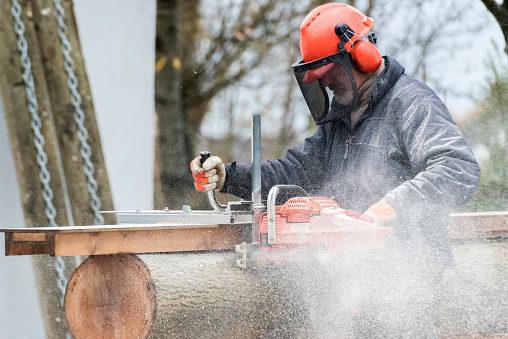
| Logger Key Stats | |
|---|---|
| Education | 1-2 Years |
| Job Outlook | -14% |
Loggers work in the open space and natural elements to harvest and procure timber.
Timber is necessary for raw material that is used to create a variety of consumer products.
Loggers collect timber from forests and harvest raw material from thousands of acres of land on a yearly basis.
Logging professionals harvest timber as part of a crew and work as part of team in order to collect the raw material.
Each logger has his own set of responsibilities and specializes in one part of the timber cutting process.
This is necessary in order to harvest timber in the most efficient and safe manner possible.
Loggers may specialize in the following jobs and duties and work together as a team:
- Tree fallers or tree harvesting machine operators: responsible for cutting done trees using powered saws or similar equipment
- Bucker: cuts larger pieces of timber to smaller logs
- Logging skidder operator: drag and maneuver cut trees to a loading deck
- Equipment operator: loads cut up logs onto a transportation vehicle such as a truck
A Logger would focus on one of the above mentioned specialties and would work with other loggers as a team in order to complete a job in an efficient and safe manner.
Candidates who want to know how to become a Logger should continue to read below to learn about education requirements, a general job description, salary and wage expectations and the career outlook.
Table of Contents
Education Requirements to Become a Logger
Most logging employers require candidates to have a minimum of a high school diploma in order to become a Logger.
Logging workers can learn all the necessary skills through on the job training.
While learning from more experienced workers, new employees can learn how to use machinery, the dangers involved with foresting and other necessary equipment.
There are some other requirements that those who want to become a Logger should be able to fulfill.
Because the logging industry can be a hazardous environment, those who want to become a Logger are required to attend safety training.
Safety trainings can be offered through logging associations, logging manufacturers or state forestry groups.
In addition, some technical and vocational schools offers 2 year Associate’s programs in forest harvesting.
Students who complete one of these programs may have better opportunities for finding employment.
Some important skills that Loggers should have include having the physical stamina to be able to work long hours with this physically demanding job.
In addition, candidates should be able to perform these tasks under a variety of climates and weather.
Logger Job Description
A Logger’s responsibilities would depend on what their title is.
A Logging team would have to be able to determine the best environment to begin cutting timber from.
Some members of the team would also have to clear the area from brush, plants and shrubbery in order to reach the best timber.
The team would then be responsible for “felling” trees; this means sawing and cutting enormous trees in a safe manner.
After the trees have been safely cut, a team member would remove branches and shave limbs.
Another team member would then chop the timber into smaller lengths in order to make it easier to transport; the Bucker would cut timber according to what the manufacturer requires.
Finally an equipment operator would transfer the raw materials onto a truck or trailer which will be transported to manufactures.
Logger Salary and Career Path
The logging industry is expected to experience slow growth through the year 2018 at 6%.
Some factors affecting this growth include the importation of logging that is cheaper to produce as well as the advancements in technologically that has created more efficient ways to log.
Even with this slow growth, candidates can expect good opportunities due to Loggers going into different professions.
The Bureau of Labor Statistics reports that the median wage for Loggers is approximately $15 per hour.
Exact wages will depend on the logging specialty, location and the size of a logging company.
Positions in Alaska are likely to pay higher wages.
Loggers who specialize in falling make the lowest wages while Loggers specializing as graders and scalers make the highest wages.
![]() The below information is based on the 2023 BLS national averages.
The below information is based on the 2023 BLS national averages.
National Average Salary
$49,790Average Salary by State
| State | Avg. Annual Salary |
|---|---|
| Alabama | $47,440 |
| Alaska | $59,790 |
| Arizona | $49,340 |
| Arkansas | $46,470 |
| California | $61,580 |
| Colorado | $48,570 |
| Florida | $47,580 |
| Georgia | $53,040 |
| Idaho | $69,890 |
| Illinois | $50,640 |
| Indiana | $44,440 |
| Iowa | $56,150 |
| Kentucky | $33,130 |
| Louisiana | $53,190 |
| Maine | $45,340 |
| Maryland | $48,730 |
| Massachusetts | $46,120 |
| Michigan | $46,450 |
| Minnesota | $46,580 |
| Mississippi | $43,370 |
| Missouri | $45,650 |
| Montana | $50,590 |
| New Hampshire | $48,680 |
| New York | $43,800 |
| North Carolina | $43,150 |
| Ohio | $43,030 |
| Oklahoma | $38,960 |
| Oregon | $59,780 |
| Pennsylvania | $42,860 |
| South Carolina | $44,720 |
| South Dakota | $53,210 |
| Tennessee | $43,740 |
| Texas | $48,360 |
| Vermont | $44,070 |
| Virginia | $48,500 |
| Washington | $66,670 |
| West Virginia | $34,610 |
| Wisconsin | $45,940 |
The top earning state in the field is Idaho, where the average salary is $69,890.
These are the top 5 highest-paying states in the field:
* Employment conditions in your area may vary.
Frequently Asked Questions
What does a logger do?
Loggers harvest timber that is used as raw material for a variety of products.
They cut down trees, fasten cables around logs and drag them with tractors.
As a logger, you will also have to separate logs by species, grade them according to knot size, straightness, and other characteristics and inspect equipment to make sure that it can be safely used.
Usually, a logging team has more members, each one with a specific role: some cut down trees, others trim the tops and branches of the trees that have been cut down, others scale tall trees and remove limbs, others fasten cables on the logs to make them draggable by tractors, and others specialize in sorting logs according to various characteristics.
As a logger, you have to follow very strict safety procedures in order to avoid injury.
Loggers also need physical strength, attention to detail, decisionmaking skills and communication abilities.
How much does a logger make?
According to the Bureau of Labor Statistics, the median annual wage of loggers was $40,650 as of May 2018 but salaries vary depending on many factors, including industry, region and the logger’s level of expertise.
Entry-level loggers can make less than $25,000 while more experience loggers can earn up to more than $60,000 a year.
How much does it cost to become a logger?
Loggers typically need a high school diploma and they learn the ins and outs of this profession through on-the-job training.
Certificate and associate’s degree programs in forest technology are also available at some technical schools.
Costs vary widely depending on the school you choose and the program itself.
Loggers typically need a high school diploma and they learn the ins and outs of this profession through on-the-job training.
Fees for programs that last more than two years can sum up to more than $10,000-$15,000 in total.
Safety training should play an important part in a logger’s instruction and training sessions designed to teach loggers how to practice logging techniques and safely use the equipment are offered by many associations.
What is the demand for loggers?
According to the Bureau of Labor Statistics, the employment of loggers is expected to decline 14 percent from 2018 to 2028.
This decline is caused, in part, by the fact that logging operations are becoming more mechanized and fewer workers are needed.
However, some new jobs may result from the need to thin forests that are at risk of wildfires.
Logging work is seasonal in many regions and loggers may experience periods of unemployment.
How long does it take to become a logger?
The answer to this question depends on the education route you choose to pursue.
You can find entry-level employment in this field with a high school diploma and learn on-the-job logging techniques and how to safely use the equipment.
Some technical schools also offer training programs in forest technology and these programs can last up to 2 years.













